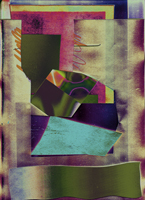For an abstract artist who primarily uses digital artistic tools like Photoshop, Travess Smalley comes off as peculiarly traditional. “I’m a painter,” Smalley told ARTINFO over G-chat, “who doesn’t paint.” His compositions blend computer graphics with physical collage-making for a final product that looks like a cross between a canvas and a screen saver. Though the artist — who is currently in London for a group show — cites influences as varied as the cut-up compositions of Henri Matisse and the aesthetics of Trapper Keeper binders (popular with kids in the ’80s and ’90s when the 27-year Smalley was a tot), his biggest inspiration at the moment is Abstract Expressionist Lee Krasner whose canvases he calls “dynamic” and “confident.” “There is an investment in the image and creating images,” he said, “that I am greatly drawn to in her work.”
One can see what he means. Smalley’s first solo exhibition in New York, “Capture Physical Presence,” which is currently on view through June 8 at Higher Pictures gallery, presents a selection of works that, from a distance, appear to be similar in look and feel to abstract paintings. Smalley’s “Capture Physical Presence #51” (a photomontage of black-and-white lozenge-like shapes) could be an update to Krasner’s “Night Creatures” (1995) — a picture of swirling two-toned ovals. But get closer to Smalley’s work and rather than seeing gobs of encrusted oil paint you’ll see a flat surface with hints of digital language — with smooth color gradients, perfectly cut shapes, and layered textures. The works are both prosaic and new-feeling, which is all part of Smalley’s plan.
Though he’s young, and relatively little known, demand for work by this West-Virginia-born artist is already strong. All six works on view have been sold to private collections, some in presales. But that shouldn’t come as a huge surprise. The artist has had little difficulty stirring interest in his work thus far — his hybrid abstractions were included in group shows worldwide even before he finished school. In 2011, he was included in the show “BYOB Venezia” at the Venice Biennale where he showed one of his “abstract visualizer videos” — a digital composition that looked like one of his paintings except that it appears to be rippling, like a windblown pond. This year, he was in the group show “Decenter: An Exhibition on the Centenary of the 1913 Armory Show,” at the Abrons Arts Center, which featured 27 artists (including Sara VanDerBeek, Cory Arcangel, Andrew Kuo, and Liz Magic Laser) who “explore changes in perception brought on by the digital age” and whose work reflects the fragmentation and nonlinearity of the Cubist lexicon.
Fragmentation and nonlinearity are Smalley’s calling card. He starts out by creating digital paintings in Photoshop. After printing them out on a color laser printer, he cuts them up, and makes them into a collage using other source material like construction paper, drawings, and color gradient backdrops from magazines. After he’s done with his work (generally laid out in the standard dimensions of a sheet of paper), he’ll scan it back into the computer and further manipulate the collage in Photoshop in a process he likens to “a feedback loop.” Then he’ll blow up the final product to a much larger size and print it out. Each, though theoretically reproducible, is kept unique.
Smalley studied painting and digital printmaking at Virginia Commonwealth University (2006) and went on to receive his BFA from Cooper Union in 2010. Though he had been making paintings, collages, and drawings, it was in 2010 at his Bushwick studio — a converted school — that Smalley first started scanning his images and combining his “very physical studio practice” with digital painting and image making. “When I made it digital, it opened up a whole other plane of options: opening the image in Photoshop, selectively changing colors, cutting out areas, rearranging areas. Very quickly I began to notice the similarities of the digital and physical side of my art making practice.”
Currently, Smalley is working on “Compositions in Clay,” a series of clay-based creations, for which he packs colorful clay onto a scanner bed to create high resolution scans he will then use as source material that he’ll digitally manipulate. That series will also be shown at Higher Pictures in late 2013 or early 2014, for the second of the two solo shows he’s on board for. He also hopes to do more “video vizualizers” (moving digital abstractions) when he finds the right programmer. “2-D static images are hard enough to show,” he said. “Showing animated work through time has so many other variables.”

